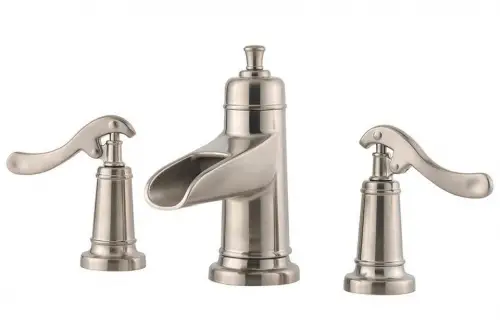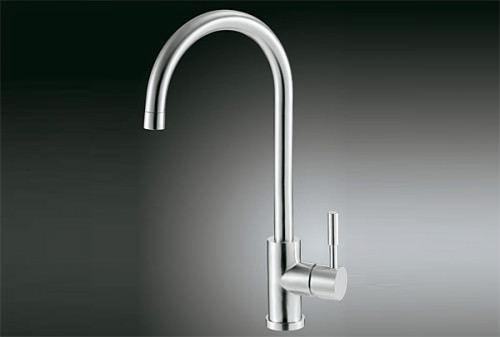As two of the most popular fixture finishes, brushed nickel and stainless steel bear several similar features. However, they are completely different, particularly in terms of finish, color, and maintenance.
Summary Table
| Brushed Nickel | Stainless Steel |
| Made up of copper, zinc, or nickel | Made up of around 10.5% to 28% chromium, iron, and carbon |
| Made with the use of a wire brush or a similar brushing tool | Made from the process of electroplating |
| Color: silver-brown and earthy | Color: metallic |
| Semi-glossy or matte finish | Shiny, metallic finish |
| Easily displays spots | Highly resistant to spots |
| More challenging to maintain | Easier to maintain |
| Less resistant to rust and corrosion | More resistant to rust and corrosion |
| Inferior type of fixture finish | Superior type of fixture finish |
| Less expensive | More expensive |
Definitions

Brushed nickel is a type of nickel finish that can be used as a plating in the construction industry. Brushed nickel a material made up of copper, zinc, or nickel, which is a silvery-white metal used to manufacture non-ferrous alloy and steel. It is created by the use of an intricate brushing process, and it is a cheaper than pure nickel.

Meanwhile, stainless steel, also called inox steel, is a type of metal made up of around 10.5% to 28% chromium, making it highly resistant to corrosion. It is an alloy of carbon and iron and is typically used in the construction industry.
Brushed Nickel vs Stainless Steel
Despite playing equally important roles, there is a difference between brushed nickel and stainless steel.
Process
Brushed nickel is a material made up of copper, zinc, or nickel, which is a silvery-white metal used to manufacture non-ferrous alloy and steel. It is produced by the use of a wire brush or a similar brushing tool, which creates small consistent grooves on the metal.
Stainless steel, on the other hand, is a steel alloy made up of around 10.5% to 28% chromium, iron, and carbon. Stainless steel used as a fixture finish, however, is not made up of pure stainless steel. Instead, it is a steel or brass material that undergoes electroplating, which is a process used in plating one type of metal to another to eliminate chances of corrosion.
Color
Brushed nickel and stainless steel are the most prominent fixture finishes used, not just in domestic homes, but in business establishments as well. Between the two, brushed nickel is more commonly used in bathroom and kitchen fixtures due to its brown and earthy tone. Stainless steel, by contrast, is metallic in color.
Finish
Brushed nickel is distinct for its semi-glossy or matte finish that looks more textured because of its uniform, brush-like grooves. Meanwhile, stainless steel always has a shiny, metallic finish.
Maintenance
Unlike brushed nickel, stainless steel is highly resistant to spots, making it easier to clean. Regular maintenance of a stainless steel fixture includes cleaning the surface with water and a clean cloth and drying it with a towel. Use a mild soap and warm water to clean the fixture. Rinse the water and soap off. If the fixture is extremely dirty, use a scratch-resistant cream to clean them. But avoid using steel wood pads, as these can damage the finish.
To compare, since brushed nickel is more vulnerable to displaying dirt spots, daily maintenance typically involves wiping the surface area with a soft cloth and a pH-balanced liquid soap. For deep-seated dirt, a 50-50 solution made up of vinegar and water (mix the vinegar and water in the spray bottle and shake to mix. Allow the mixture to sit for about 1 minute.) should be sprayed into the surface before cleansing and drying.
Durability
The durability of a fixture finish is highly dependent on the brand and the type of steel used during manufacture. Nonetheless, between stainless steel and brushed nickel, the former is usually more durable and more resistant to rust and corrosion.
Price
Lastly, since stainless steel is considered a superior type of metal, it is more expensive than brushed nickel and other fixture finish variants.
Which One to Choose: Stainless Steel or Brushed Nickel?
Choosing between stainless steel or brushed nickel finishes can be pretty challenging. But there are some considerations to keep in mind when choosing between these finishes:
Aesthetic: the first consideration is to think about the overall aesthetic of your room. How will brushed nickel or stainless steel fit in with your décor and existing materials in the space?
Durability & maintenance: next, consider the durability and maintenance needed for both materials. Stainless steel is resistant to corrosion and rust, as well as water spots. It makes a great choice for long-term use. On the other hand, brushed nickel is also durable; however, it does require more cleaning, as it is prone to water spots. It also requires special cleaning methods that do not scratch the surface.
Budget: when it comes to the budget, brushed nickel is usually more expensive to due to the coating process. On the other hand, stainless steel is more reasonably priced and fits into a tight budget more easily.
Weight & installation: another consideration is the weight of the fixture and whether the installation can support its weight. Stainless steel fixtures are usually heavier than those made of brushed nickel.





